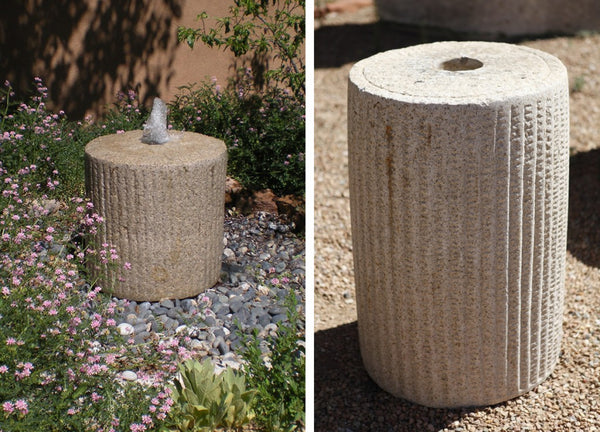Chinese Grain Mill, circa early 1900s | Photo scanned and posted by Wolfgang Wiggers of Ottersberg, Germany
Take a closer look at this image. There are two granite components that make this mill work: a stone roller/runner stone (on top) and a millstone/bedstone (on bottom). By combination of repeated rotation, heavy weight, and carved ridges in the stones, the donkey grinds the grain down for everyday use. The ridges on a pair of grinding stones work together to cut the grain down as they rotate.
Look even closer. See the faint, star-shaped pattern carved into the top of the stone roller? 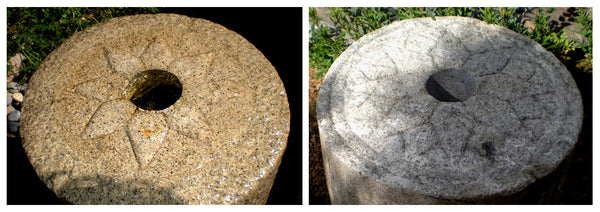
The drawings below also show this traditional method of grinding in China. The contemporary artist Huang Rui recreated the millstone for an exhibition in Beijing in May 2012. Titled Rumor Mill, the millstone was used to grind 5 different kinds of grain with a real donkey, which were then bottled, signed and sold on-site.

The drawings below also show this traditional method of grinding in China. The contemporary artist Huang Rui recreated the millstone for an exhibition in Beijing in May 2012. Titled Rumor Mill, the millstone was used to grind 5 different kinds of grain with a real donkey, which were then bottled, signed and sold on-site.
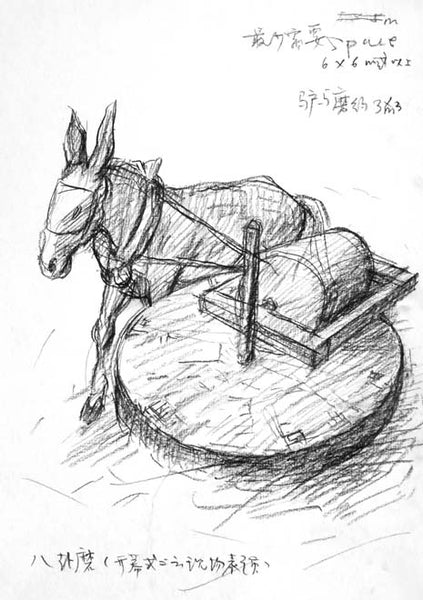
Sketches for the installation Rumor Mill by Huang Rui | Designed for RAZE: a site-specific exhibition in Beijing.
And here is another more recent set-up, showing how the top runner stone circulates:

The repeating patterns on the surface of a millstone are called harps, and are made up of furrows (grooves) and lands. Our small antique millstones have eight harps, for example.
When these grinding stones were joined face-to-face, they created a cutting motion, almost like scissors. Due to the wear & tear from repeated grinding, stones periodically had to be re-cut, or dressed, to maintain their sharpness.
Here at Stone Forest, we have 3 types of antique grinding stones available for use as water features or decorative sculpture. Each unique stone is about 100 years old, and carved from beige granite.
1. Antique Millstones (or bedstones, as discussed above)
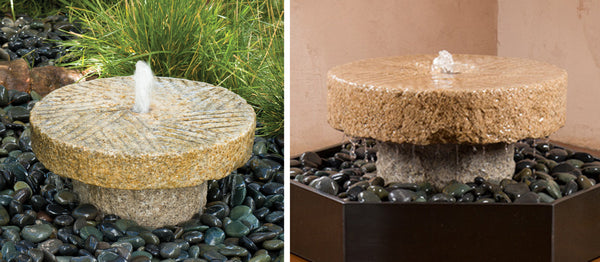
Small Antique Millstones | Approx 11″H x 19-24″ diam

Large Antique Millstones | Approx 16″H x 48″ diam | Our “One-of-a-Kind” gallery shows available designs

Owners Michael Zimber (left) and Michael Cahill (right) stand atop one of the Colossal Antique Millstones | Approx 30″H x 65″ diam | Our “One-of-a-Kind” gallery shows available designs
2. Antique Grinding Stones (or runner stones, as discussed above)
3. Antique Grinding Basins
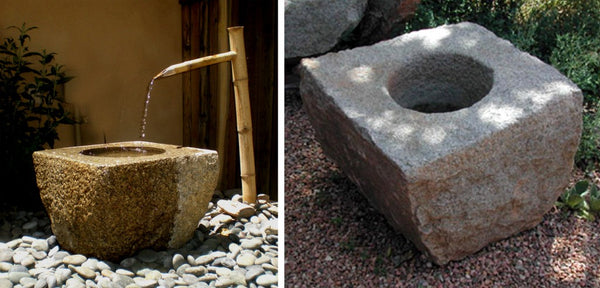
Our “One-of-a-Kind” gallery shows available designs
These square-shaped basins would have been used as a “mortar and pestle” for grinding grain by hand: a smaller-scale version of the millstone operation explained above. Another commonly-used grinding method is with a rotary quern, or hand mill, as shown below:

The grinding abilities of millstones have caused an evolution of size, pattern, and style used for different types of industry all over the world, ranging from agave to cork to corn to wheat. There are many working mills still in operation today that show demonstrations in technique and continue to sell their grain.
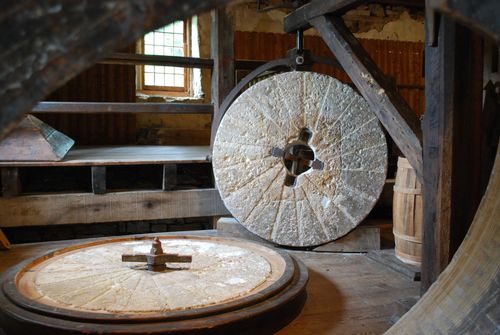
Wye Grist Mill, MD | Photo by learningasigo
After extracting a millstone from rotation for reasons including cracking or deterioration that could not be re-surfaced, these features were used for a variety of applications such as stepping stones, miller’s gravestones, water features, and outdoor walls among others. Millstones have evolved into decorative elements that have a massive presence, beauty of pattern, and worn sculptural history.
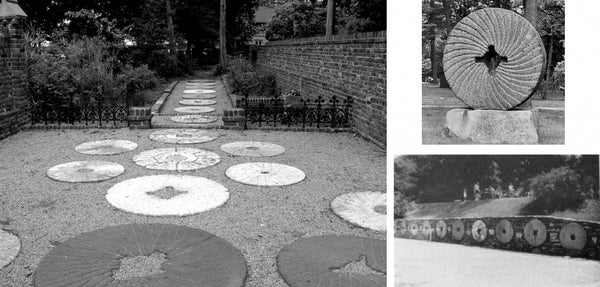
Images show use of old millstones as stepping stones, a gravestone, and retaining wall features.
So as you consider your own landscape, take a moment to ask yourself if the presence of a well-worked, well-loved millstone or basin would enrich your space as it begins its second life as a recirculating fountain. We’re betting it will.

Sources |
Flory, Paul B. Old Millstones. Native Cocalico and French Buhr Stones. Embedded in a Retaining Wall by the Flory Tennis Court, at Martic Forge, PA. http://www.angelfire.com/journal/pondlilymill/flory1.html
Hazen, Theodore R. and Pond Lily Mill Restorations. The Art of Millstones, How They Work. http://www.angelfire.com/journal/millrestoration/millstones.html
Hermitage Museum & Gardens, Norfolk, VA. Source for image: http://www.thehermitagemuseum.org/gardens/millstones
learningasigo. At the mill. Blog post. Posted July 18, 2009. http://learningasigo.typepad.com/learning_as_i_go/2009/07/at-the-mill.html
Jones, R. M. Sleepy Hollow Cemetery, Concord, MA. Source for image: http://www.thevlecks.net/rmj/sleepyhollow1.jpg
Scheer, Matthew. http://threekeywords.com/rarehowto/?p=138
Wiggers, Wolfgang/ookami_dou of Ottersberg, Germany. Source for image: http://www.flickr.com/photos/15693951@N00/3923551744/.
Wikipedia: The Free Encyclopedia. http://en.wikipedia.org/wiki/Millstone



